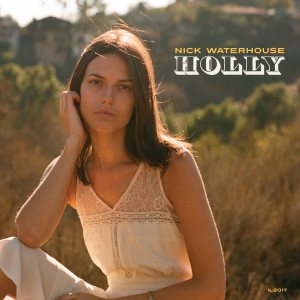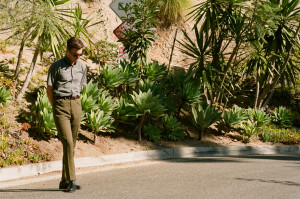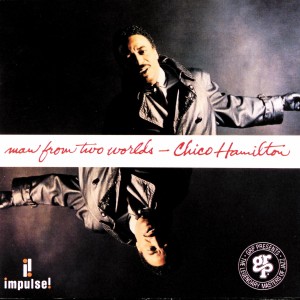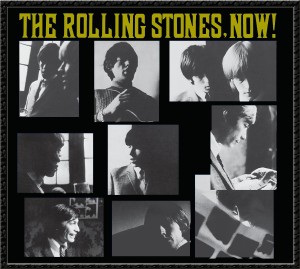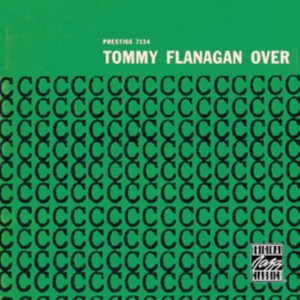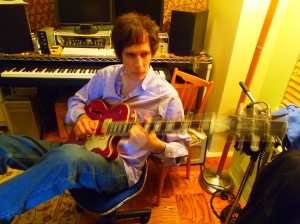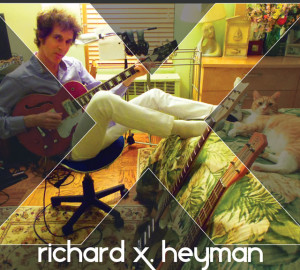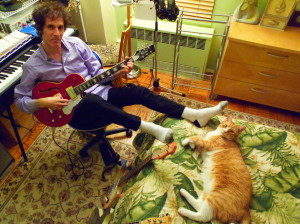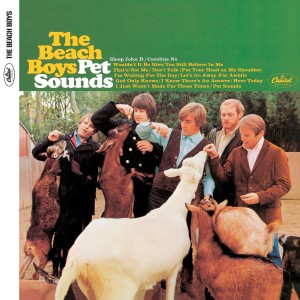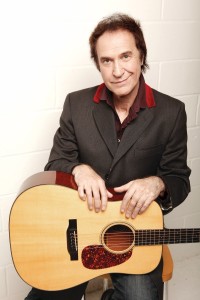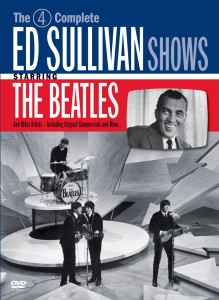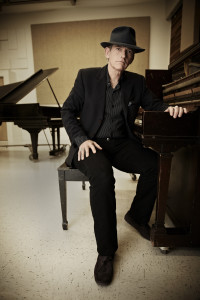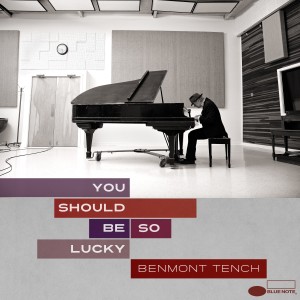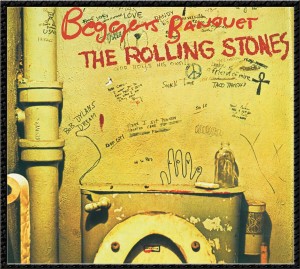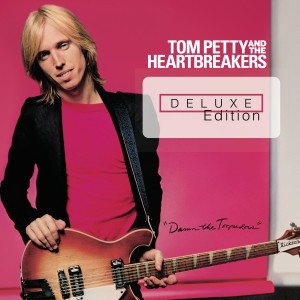Call him The King of Retro Cool. You may have seen Nick Waterhouse wondering “where you think you’re gonna go/when your time’s all gone?” in the current Lexus CT Hybrid “Live a Full Life” commercial campaign, but his super-snazzy brand of modern jazzabilly rock extends well beyond that 30-second snippet. His second full-length LP, Holly (Innovative Leisure), builds on the retro-rockin’ bed of 2011′s Time’s All Gone. Waterhouse and I recently convened to talk about Holly‘s sonic merits, his favorite vinyl reissues, his playback gear, and the benefits of recording in mono.
Mike Mettler: Was Holly recorded direct to tape?
Nick Waterhouse: It was! I did the record at Fairfax in Van Nuys, [California], which is where the Sound City studios used to be. Kevin Augunas was my co-producer on the record. We used four Scully 16-track recorders gotten from A&M Studios, so they’re really ... Read More »]]>
Call him The King of Retro Cool. You may have seen Nick Waterhouse wondering “where you think you’re gonna go/when your time’s all gone?” in the current Lexus CT Hybrid “Live a Full Life” commercial campaign, but his super-snazzy brand of modern jazzabilly rock extends well beyond that 30-second snippet. His second full-length LP, Holly (Innovative Leisure), builds on the retro-rockin’ bed of 2011′s Time’s All Gone. Waterhouse and I recently convened to talk about Holly‘s sonic merits, his favorite vinyl reissues, his playback gear, and the benefits of recording in mono.
Mike Mettler: Was Holly recorded direct to tape?
Nick Waterhouse: It was! I did the record at Fairfax in Van Nuys, [California], which is where the Sound City studios used to be. Kevin Augunas was my co-producer on the record. We used four Scully 16-track recorders gotten from A&M Studios, so they’re really nice. And I feel it imported a lot of that character, because Scullys are known to be precise and have a kind of different warmth than Ampexes do. I was so pleased with the results.
Mettler: I really got a sense of the character of the room and space you recorded in, because Holly has that special, live off-the-floor feel.
Waterhouse: Oh yeah yeah yeah! I’m a big advocate of cutting live. A lot of this record was tracked with the keys, rhythm guitar, bass, and drums all together.
Mettler: On a song like “Well It’s Fine,” you really hear the subtlety and detail with [Richard Gowen's] brush drums on the intro.
Waterhouse: That tune was a favorite of mine, even though it’s the most minimal. You can hear so much of the room, and everything was cut live. Listening back to it gave me the chills. It reminded me a lot of the [Rudy] Van Gelder productions for the Blue Note jazz stuff.
Mettler: It’s all got that cool, early-’60s, everybody-is-looking-at-each-other feel. And I love the sax solo on “Dead Room” —
Waterhouse: Mm-hmm, that’s the very talented Jason Freese on tenor sax.
Mettler: “This Is the Game” has some sweet horns in the intro and then that nice organ interplay in the middle. Everything sounds so good digitally, so it begs the question: How good does this album sound on vinyl?
Waterhouse: You’ll love it! I’m very excited. I had the very talented Kevin Gray master it, and had Quality Record Pressings in Salina, Kansas press the record. As you probably know, they did Quality Pressings of some of the Prestige and Blue Note stuff.
Mettler: Oh yeah, that’s as prime as it gets.
Waterhouse: They cut it on the same machine that they do their deep-groove reissues with. Holly is 180-gram on a single disc, at 33. I stayed conservative in that sense. I’m really pleased, because the record clocks in at 31 minutes.
Mettler: That’s nice, so you didn’t have to make any compromises at all on either side.
Waterhouse: Not at all. I’m really excited how “Sleepin’ Pills” ends the groove of Side 1.
Mettler: Man, I have to get a copy ASAP. You must have etched something into the runout groove, too.
Waterhouse: Oh yeah, there’s always a little message there.
Mettler: What kind of turntable do you have?
Waterhouse: I have one of those old VPI Classics that I really like a lot. I used to have an Empire 298 that I really liked, and I actually moved that to my office at the studio. I picked up the VPI secondhand last year, with my first big recording check. I figured that was the best way to reward myself. [both laugh] And that goes through a nice Fisher X-101-B receiver. I like the phono stage on that a lot.
Mettler: What kind of speakers do you run through?
Waterhouse: Klipsch Heresys. To me, that’s a very classic high-level consumer system. Most of what I listen to are mono jazz LPs and pop 45s.
Mettler: What kind of cartridge does the VPI have?
Waterhouse: I actually switched between a Denon DL-102 and DL-103. I have the 103 because that thing takes beat-up old 45s really well.
Mettler: What’s your current favorite record that you’re spinning on the VPI?
Waterhouse: Oh, man… well, I’m a massive fan of Chico Hamilton’s Man From Two Worlds (1964), on Impulse! That’s slightly off the beaten path, but —
Mettler: Somebody I talked to last year also recommended a Chico record… let me think for a minute [pauses]… oh yeah! It was Derek Trucks, when he called me from the side of the road. That’s totally in his blood.
Waterhouse: Oh yeah, there’s a lot of heavy jazz in his playing.
Mettler: The Dealer (1966) was the Chico record he was talking about.
Waterhouse: Oh, The Dealer is really tough! I love that record; it’s a funky record. Man From Two Worlds is more my speed, though. Derek Trucks is a little more funky than I am as a player. [chuckles]
Mettler: Smoky cool is what I’d call your kind of playing. What else can you recommend?
Waterhouse: I’m also a really big fan of Garnet Mimms, and he has two records out on United Artists. “Cry Baby” is the single [later covered by Janis Joplin], but As Long As I Have You (1964) is one of my favorite LPs of all time. It’s a really wonderful-sounding, big city, kind of New York-full kind of record with Gerry Ragovoy production. And of course, you can’t go wrong with Bobby “Blue” Bland’s Two Steps From the Blues (1961), on Duke. It’s an amazing-sounding record — and in mono, nonetheless.
Mettler: You released your first album, Time’s All Gone, in mono, right?
Waterhouse: Yeah. All my 45s are in mono, and believe it or not, Holly is in mono too. It’s funny, because I remember sitting with the mastering engineer, and he asked me three times, “This is mono??” It was great!
I come from a background of wanting to learn how to do it myself — the process of how to make the records. I had read a lot of books and interviews about engineering and recording. I never went to engineering school, but they say they teach you how to mix in mono first because if you mess up a mono mix, you mess up the whole thing, but you could squeak by in a stereo mix. But I just stop there, I don’t go any further than that statement. [laughs]
Mettler: Do you remember the first record you bought as a kid, before you worked in the record store? [Waterhouse worked at Rooky Ricardo’s Records in the Lower Haight in San Francisco when he was attending San Francisco State University.]
Waterhouse: It’s funny. There’s a series of records I didn’t put any cash down for but that my uncle gave me. It was three of the earliest Rolling Stones records: The Rolling Stones Now! (1965), Out of Our Heads (1965), and Aftermath (1966). He gave me the London pressings of those. And on top of that, he gave me a couple of Miracles, Four Tops, and a Yardbirds American reissue… what was it called…?
Mettler: It was probably the Yardbirds Greatest Hits (1967), with the “lasso” song logo on the cover, and the LP had that yellow Epic label on it. Had that one in college myself. My Dad also gave me his copy, which didn’t have the outer sleeve.
Waterhouse: Yeah, that’s it! Those records were all big parts of my life. But the first things I bought were not LPs, but two 45s: Booker T. & the M.G.’s’ “Green Onions,” and Charlie Rich’s “Mohair Sam.” Those I see as the cornerstones of my musical vocabulary, really.
Mettler: Please tell me you still have those 45s.
Waterhouse: I do, yeah! They’re in the boxes, so to speak. When I finally became a real musician, I explained to my mom that all those years spent scolding me for spending my day-job money on records was moot now.
Mettler: I love that! How do you stand in the Beatles universe in terms of mono vs. stereo?
Waterhouse: Oh, I have no opinion about that — Ray Charles was my Beatles.
Mettler: Ok, then what about The Rat Pack?
Waterhouse: Oh, The Rat Pack. I dig them, but I never got too heavy into them. I love their records in mono because that’s how they were recorded, in that format.
Mettler: Anything else on vinyl that you took a chance on that was great?
Waterhouse: Let’s see, I’m looking at my wall right now… I just got a really amazing Japanese reissue of Georgie Fame: Rhythm and Blues at the Flamingo (1964), a live record. It’s really nice, a replication of the U.K. pressing. They did a great job remastering it. I’ve got the new Charles Bradley LP here, Victim of Love (2013), which sounds really nice, and I just invested in a subscription to the Prestige Mono LPs Reissues Series, and they just sent me Phil Woods Quartet: Woodlore (1955), Hank Mobley: Mobley’s Message (1956), and Tommy Flanagan: Overseas (1957). I’m really enjoying those right now.
Mettler: Last thing: Bob Dylan. Does he filter into your universe?
Waterhouse: He does, but he came in really late. I feel grateful, actually. I like that he came in after I learned about blues, R&B, folk, and gospel, because now I see all that in there. I love him in mono, especially what’s in The Complete Mono Recordings box set. Here’s a little trivia you’ll enjoy: The console that’s now at Fairfax is the one Kevin Augunas, the owner, got from Bradley Barn, the old RCA studio in Nashville. It was built in 1965, and it might have been used to track Blonde on Blonde. How cool is that?
]]>Richard X. Heyman is a rock & roll lifer. I first became exposed to his indelible brand of garage pop on his 1990 solo album Living Room!! (Cypress), instantly falling for the hooks of “Union County Line” and “Local Paper.” (And, yes, I do have it on vinyl, folks.) Soon thereafter, I learned of his pioneering role in nearby Plainfield, New Jersey’s ’60s garage rockers The Doughboys, who continue performing live and releasing top-notch music to this day. (“Black Sheep,” “Why Can’t She See Me?,”“It’s a Crying Shame,” and “YOYO” are but four of my favorite modern-era Doughboys tracks.)
Heyman’s solo career has careened more toward the melodic side of the pop dial, though he does keep his garage roots intact. Last Fall, he conducted a successful Kickstarter campaign to fund his tenth solo record, naturally dubbed X (Turn-Up Records). ... Read More »]]>
Richard X. Heyman is a rock & roll lifer. I first became exposed to his indelible brand of garage pop on his 1990 solo album Living Room!! (Cypress), instantly falling for the hooks of “Union County Line” and “Local Paper.” (And, yes, I do have it on vinyl, folks.) Soon thereafter, I learned of his pioneering role in nearby Plainfield, New Jersey’s ’60s garage rockers The Doughboys, who continue performing live and releasing top-notch music to this day. (“Black Sheep,” “Why Can’t She See Me?,”“It’s a Crying Shame,” and “YOYO” are but four of my favorite modern-era Doughboys tracks.)
Heyman’s solo career has careened more toward the melodic side of the pop dial, though he does keep his garage roots intact. Last Fall, he conducted a successful Kickstarter campaign to fund his tenth solo record, naturally dubbed X (Turn-Up Records). I met Richard in New York City for lunch last September, and we spent a few good hours discussing X, how good The Beatles sound on vinyl, and our favorite records. Somehow, the tape of that rap session vanished like a ghost in the machine, so recently, Heyman and I reconvened to revisit the ins and outs of X, his favorite albums and influences both Beatles and otherwise, the ongoing saga of the Doughboys, and what he’ll do next.
Mike Mettler: Congratulations again on X, which was one of my Top 25 albums of 2013. I continue to listen to it now, which shows how the songs resonate with me as a listener. To me, tracks like “The Difference Between Us” and “House of Cards” are great examples of your mastery of the pop music form. Does it ever get “easier” to write songs? How do you find inspiration for your melodies and hooks?
Richard X. Heyman: Thanks. The process has remained fairly consistent for me. I get melodic and chordal ideas first, and then I have to buckle down and work diligently on the lyrics. Inspiration can come by simply having a project to work on. If I have an album to make and need material to fill it, then I tend to start coming up with new song ideas. It’s like a self-imposed pressure or deadline. Sometimes a melody can pop up out of the blue.
Another way is from listening to other music. For example, I heard a set of old Appalachian country and folk songs on the car radio, and when I got home, I had all that music swirling around in my head. I started writing a few songs, being very careful not to copy any of the melodies but using the general vibe of that stuff. And, of course, in the end, it’s all filtered through my pop sensibilities and sounds nothing like Appalachian folk music.
Mettler: You are essentially a one-man band, recording the majority of X at your home studio in New York City that you call The Kit Factory. What do you lay down first when you’re recording, the drums? How do your songs typically unfold in terms of composition and structure?
RXH: Usually I start with the drums, which I record at a proper studio. I just don’t have the equipment or space in our apartment, not to mention the risk of eviction. (On my last album, Tiers/And Other Stories [2011], I began with the piano, and then I took those tracks to the studio and played the drums to them.) Next, I (meaning Nancy Leigh, my wife and my engineer) load the drum tracks into our Logic Pro system. Then I’ll lay down a rhythm guitar or keyboard. For electric guitars, I have a semi-soundproofed wooden box that I built with an 8-inch speaker inside, and a Shure SM57 mic in front of it. I use a Fender Vibro Champ amp externally to power the speaker. After that, I sing the lead vocal, followed by the harmony vocals and then background-type things like oohs and ahhs or interweaving parts, as on “Firing Line” and on the “all fall down” part on the chorus of “House of Cards.” [Click on the link at the end of this sentence to see the “House of Cards” video.] Once the vocals are completed, I put on the bass and lead guitar parts, and last but not least, some percussion if needed, such as a tambourine or maracas.
Mettler: Harmonies are key elements of many of your songs. How do you construct them? “Firing Line” is one of my favorite examples of how you do that.
RXH: I always loved harmony singing and was and still am a big fan of The Everly Brothers and a lot of the artists that were influenced by them — Simon & Garfunkel, The Beatles, The Hollies, and The Byrds, to name a few. So I naturally hear harmonies when I’m working on a song. On “Firing Line,” I think some of the inspiration is from The Mamas and The Papas and The Beach Boys. They used a technique where there are counter-melodies underneath the main vocal line. So I tried a few different ways to get that effect, and through trial and error, found a part.
Mettler: I hear 12-string guitars all throughout X. What is it you like about that “Rickenbacker sound”? Is there an X track that has your “favorite” guitar tone?
RXH: I guess I use the Rickenbacker 12-string because it’s sitting right there and I can’t resist. Sometimes I double a 6-string, either a Telecaster or a Strat, in octaves and it sounds like a 12-string — the solo on “Firing Line,” for example. That song keeps coming up a lot! I like the guitars on the opening track, “When Denny Dropped Out of the Scene.” That’s a Strat on one side and a Tele on the other.
Mettler: How important is song sequencing to you? If X came out on vinyl, I feel like “Somebody Has Finally Found Me” would have been the perfect ending to Side 1.
RXH: Nancy and I both think about the song order. We try to get the best flow we can. Mix up the tempos and keys so things don’t sound too same-y. It’s different with CDs because it’s all in one fell swoop, so, yeah, I agree: I would have ended the first side of vinyl with “Somebody Has Finally Found Me.”
Mettler: There’s a lot of debate about the ongoing viability of the album format in today’s songs-on-demand digital world. Do you think the album remains a viable art form? What would you consider to be some of the best albums ever released?
RXH: Well, you’re asking the wrong person to question the album. As a bona-fide, card-carrying baby boomer, I grew up with the album. It seems logical if you like a particular artist that you’d want to listen to a bunch of their songs in one sitting. I wouldn’t want to go to a concert and hear 14 bands each do one song. Those people who are quick to banish the album format to obscurity have lost sight of the fact that an album is an art form unto itself. As writing a novel is to an author, so is creating a cohesive album to a recording artist. Would they get rid of novels or any other type of writing that exceeds a few pages?
As far as a favorite album, there are too many to list here, but I’ll give you a few off the top of my head, though I’m sure I’ll forget some big ones. Let’s just stick with rock albums. A Hard Day’s Night, the American Rubber Soul, Help!, Revolver… oh, what’s the point, I love all the Beatles albums. The first dozen albums by The Stones, The Kinks Kontroversy, Something Else, Face to Face, The Village Green Preservation Society, The Band, Jimi Hendrix’s Are You Experienced? and Axis: Bold as Love, The Beach Boys Today, Pet Sounds, Dylan’s first several albums and some later ones like Blood on the Tracks, greatest hits by Chuck Berry, Everly Brothers, Bo Diddley, James Brown, Sam Cooke, The Rascals, The Who Sings My Generation and The Who Sell Out, Love’s Forever Changes, The Notorious Byrd Brothers, The Zombies’ Odessey & Oracle… That said, I also grew up in the era of singles, so I appreciate the appeal and impact one song can have as well.
We literally don’t have the space for a turntable in our apartment, though we still have hundreds of vinyl albums stashed away. I have mixed feelings about vinyl records. There’s a nostalgic fondness for them because that’s what I grew up with. They do transmit the analog sound of the music of the original recording, and mixing and mastering were analog as well. The problem is, many vinyl releases nowadays are from a digital source, so it kind of defeats the purpose. Some people will argue that the vinyl itself adds some beneficial audio quality. I’m not an expert, but I can’t see how a needle dragging across a piece of plastic is adding anything to the sound. There is no question that a fully analog vinyl record has more warmth and is less brittle than a CD. The irony is that most listeners today, myself included, hear the majority of their music on tiny computer speakers.
Mettler: What, or who, inspired you to become a songwriter?
RXH: Growing up in the ’60s, with all those great songs pouring out of the radio, was infectious. I guess I just caught the bug. And to a certain extent, I think it just came naturally — once I taught myself how to play the piano and later guitar, chord changes seemed to suggest themselves to me whenever I’d pick up an instrument. But some of the biggest influences are Goffin & King, Mann & Weil, Barry & Greenwich, Chuck Berry, Buddy Holly, Holland Dozier Holland, Brian Wilson, Laura Nyro, Del Shannon, John Sebastian, Lennon & McCartney, Bob Dylan, John Phillips, Jagger & Richards, Paul Simon, Graham Gouldman, Ray Davies, Gene Clark, Pete Townshend, Robbie Robertson, and Joni Mitchell, to name a few.
Mettler: You started playing drums at age 5, and have cited Gene Krupa and Buddy Rich as early influences. What was it about their styles that appealed to you?
RXH: They were the two biggest drum stars and they were both excellent musicians, but I was inspired by all the different drummers I’d see on TV or hear on jazz records my father bought. The thing with Gene and Buddy was how flamboyant (no pun intended) they were. It looked like a lot of fun to be pounding on those beautiful tubs.
Mettler: Do you remember the first record you bought with your own money? Do you still have it? What made it stand out to you?
RXH: I bought records as a young adolescent, but not with my own money. I would say the Bee Gees 1st album in ’67 is when I had saved up enough money from playing gigs with The Doughboys to afford not only my own albums but I got a nice Dual turntable and stereo too. It was very exciting to have a stereo in my bedroom. I did love that first Bee Gees album; every song is a gem. I don’t have the original one I bought, but I do have a vinyl version as well as the CD. There were a bunch of albums coming out at that point that I remember buying: Are You Experienced? (I learned a lot listening to Mitch Mitchell), The Crazy World of Arthur Brown, stuff like that.
Mettler: Did you see The Beatles on Ed Sullivan [on February 9, 1964]? How did The Beatles affect you as a listener and, ultimately, a singer/songwriter/performer? And yes, I know that’s a bit of a loaded question…
RXH: I first heard The Beatles on New Year’s Eve of ’63 into ’64. It was “I Want To Hold Your Hand” on WABC. Then I saw them perform “She Loves You” on The Jack Paar Show a few days later. I was awestruck on several levels. First, I couldn’t believe they were a self-contained band. Other than The Beach Boys, you just didn’t see that many bands with guys playing and singing. Then of course there was the visceral, cultural shock of their image. And most important was the music. “She Loves You” hit me really hard. It had all the elements I love about rock’n’roll — great Everly Brothers-style harmony, cool Chuck Berry-ish guitar riffs, and those chord changes which tugged at your heart strings. It was all too much, to quote George Harrison. By the time they appeared on Ed Sullivan, I was a certified Beatlemaniac. I sat about 3 feet in front of our 23-inch Zenith console with my entire family behind me, trying to soak in as much of it as possible. After the show was over, I went up to our attic where I had my drums set up in a spare bedroom. I knew I wouldn’t be able to sleep that night, so I just sat behind my Kent drum set and lightly tapped the snare drum with my fingers because it was too late to play. That August of ’64, I saw The Beatles live at Forest Hills Tennis Stadium, and later at Shea Stadium [August 15, 1965]. I could go on, but I think you get the picture.
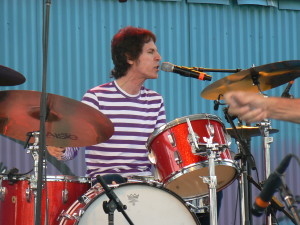
The Groove You Knead: Heyman behind the kit with the Doughboys in Atlanta in August 2008. Photo courtesy Richard X. Heyman.
Mettler: Tell me a bit about The Doughboys. Why is it fun to play and record with them today, after having planted the initial garage-rock seed back in the ’60s?
RXH: The Doughboys, for those who don’t know, was the band I played drums in back in the ’60s. We formed in September of ’64 and released two singles on Bell Records, and we were the house band at the Café Wha? in New York, 2 years after Hendrix got his start there. We split up by ’69. After that, there were some short-lived combinations of the guys getting together in the early ’70s, then we went our separate ways for, oh, 35 years. We got back together in 2000. It was going to be a one-off gig that Nancy had arranged as a surprise for my birthday, but turned into a now-14-year second act for the band.
One reason why it’s so much fun is because I’ve known Mike Caruso (our bass player) since he was in first grade and I was in kindergarten, back in Plainfield, New Jersey. When you know somebody your whole life, there is a special bond, and that bond translates itself in our bass/drum rhythm section. And then there’s Myke Scavone, who is so strong up front singing lead, playing blues harp, and putting on a riveting show. Sadly, our original guitarist Willy Kirchofer passed away in 2005 — he was a force of nature on guitar. Our “new” guitar player, Gar Francis, another Plainfield native, is a one-of-a-kind talent. He gets an incredible sound out of a tiny Fender amp without any pedals or gizmos. It’s all in his fingers. Plus, he’s a terrific songwriter. What’s interesting and makes it so much fun is the fact that we’re rocking harder and playing better than we did in the ’60s!
Mettler: To circle back to X, do you have plans for a followup record yet, and will you call it XI?
RXH: Well, I did issue a bonus album from X called Y to the Kickstarter contributors. Currently, I’ve been writing a lot of songs for The Doughboys’ next album, which we will be recording soon. I have been pondering what to do next for my own project. I was thinking of maybe a folky kind of album with acoustic guitar. I have some potential titles — All Folked Up or RXH Gets All Folk On Yer Ass. Or my favorite — a picture of Nancy and me ambling down a snowy Greenwich Village street and calling it The Jay Walkin’ Richard X. Heyman. We’ll see.
]]>“I don’t want to stop anyone from getting the CD, but vinyl is the truest way to hear this record,” says Benmont Tench about his new solo album, You Should Be So Lucky (Blue Note). “When you have Glyn Johns [The Rolling Stones, Eagles, The Who] recording something to tape, you really want to hear it on vinyl.” It’s hard to argue with the longtime Tom Petty & The Heartbreakers keyboardist, stepping out to be a frontman for the first time in his five-decades-long career. And spinning Lucky on 180-gram vinyl very much tells the tale of the details: the delicate brush drumwork and resonating bass on “Ecor Rouge,” the placement of the string quartet behind Tench’s organ lines on “Hannah,” and Tench’s deft touch on the ivories while a guitar solo caterwauls in the left channel on ... Read More »]]>
“I don’t want to stop anyone from getting the CD, but vinyl is the truest way to hear this record,” says Benmont Tench about his new solo album, You Should Be So Lucky (Blue Note). “When you have Glyn Johns [The Rolling Stones, Eagles, The Who] recording something to tape, you really want to hear it on vinyl.” It’s hard to argue with the longtime Tom Petty & The Heartbreakers keyboardist, stepping out to be a frontman for the first time in his five-decades-long career. And spinning Lucky on 180-gram vinyl very much tells the tale of the details: the delicate brush drumwork and resonating bass on “Ecor Rouge,” the placement of the string quartet behind Tench’s organ lines on “Hannah,” and Tench’s deft touch on the ivories while a guitar solo caterwauls in the left channel on the Professor Longhair N’awlins-style tribute “Wobbles.” Here, we wax on about the value of what you get in the grooves, his turntable and his favorite albums, and how to reach “The Grail.”
Mike Mettler: What was your sonic goal for the vinyl version of You Should Be So Lucky?
Benmont Tench: I wanted it to sound like the tape. I mean, it’s Glyn Johns producing! So we recorded to tape, no Pro Tools. The first hint of digital media was when it was mastered to CD. I just want people to hear it as close to the tape as possible. Chris Bellman did the vinyl mastering, and it sounds fantastic. It was important for me that we got the details across to those who would appreciate it. For example, at the beginning of the very first track, “Today I Took Your Picture Down,” there’s some air in the way the sticks drop onto the snare that’s just lovely.
Mettler: To me, that song has a modern, Southern Accents kind of feel to it.
Tench: Oh, nice. We didn’t think about it; we just started playing. I don’t know what Glyn said to the other musicians, but he encouraged me to play the song and not tell other people what to play — which was fine by me, because they’re all my friends. I love playing with them, and I learn something new every time. And it’s a live track. The vocal is live, and nobody punched anything in.
Mettler: And you recorded the band live off the floor, too. Me, I happen to like hearing bleedthrough. When something reverberates off of a snare drum because you’re right there in the room with it, that’s as real as it gets.
Tench: Exactly! You get the blending of the soundwaves of the two guitars mixing in with each other. And sometimes you get the vocal sound and piano sound on one mike, like we did on “Duquesne Whistle” and “Hannah.” Because I sing so quietly, they had to turn the mike up really loud, so we got the piano in the vocal mike. At one point on “Duquesne,” I asked Glyn, “Can I re-sing that one line?” and he said, “No, dear boy, you can’t. It can’t be done. No way.” [both laugh]
Mettler: I’m glad Lucky is spread out over four sides — and it has two bonus tracks, too. The side breaks are important for feeling the mood shifts on this record.
Tench: All I listen to are LPs, so it’s important to me to have the sides. You listen to four or five songs at a time; that’s a good chunk of music. Sides have their own character. And you can have a favorite side of an album, like we do with Exile on Main Street or The White Album.
Mettler: What kind of turntable do you have?
Tench: It’s a Pro-Ject model, one from the RM Series, the 5.1 SE, and I have the Blue Point No. 2 cartridge. It sounds like a million bucks. Steve Ferrone [drummer with the Heartbreakers] gave me some JBL 4408A studio monitor speakers to go with them. I’m old school. I haven’t gone surround yet. I’m sticking with stereo.
Mettler: What are some of your favorite albums to spin?
Tench: I love records that Bob Dylan made, especially the early funny ones. [both laugh] I really love John Wesley Harding. The one thing I know about Bob Dylan is that it’s a fool’s game trying to figure out Bob Dylan. I’ve learned that first hand. You think he’s saying something clever, and you find out he’s just telling the truth. But that’s what appeals to me about making music, you know?
Mettler: I do. The vinyl reissue of John Wesley Harding is so beautifully stark.
Tench: I don’t have the reissue because I have a really good original.
Mettler: You should get it. And get the Mobile Fidelity remaster of Blonde on Blonde too — it’s soooo good.
Tench: Oh good, it’s by Mobile Fidelity. I don’t trust most reissues unless they specifically say they’re from the analog tapes; a lot of them are done from a digital source. I think you get more of the original signal on vinyl than you do on a 16-bit CD anyway. Vinyl is still the better way to listen, even if the album was originally recorded digitally. I’ve never woken up and gotten lost in the music by listening to a CD. I dig the CD format a lot, but it doesn’t lead me down a rabbit hole like vinyl does. There’s something with the vinyl experience that just draws you in where you can taste it.
Mettler: Any particular record that takes you away every time?
Tench: Oh yeah: Beggars Banquet, Black and Blue... I could go on and on. My thought is, if you’re not listening to vinyl, you’re kind of cheating yourself. I know people have different tastes, and some people really like the sound of digital. MP3s are great for convenience when you travel, but that’s just about it. You’re cheated out of a lot of warmth and richness of any recording. MP3s are better than not listening to music at all, but still — you’re being cheated.
Mettler: Hard to disagree with you there. Back to Lucky being on vinyl. Putting it on four sides was good call, since it gives you room for the arrangements to breathe. There’s a lot of good bass content on “Blonde Girl, Blue Dress,” which kicks off Side 2, and especially the tambourine —
Tench: I love the way Tom [Petty] plays bass on that one. And that tambourine player, Ringo [Starr] — I think there’s a future for him. You should hear him behind a kit.
Mettler: That might be a good idea. You might want to suggest that to him.
Tench: If only he wasn’t such an unpleasant character. [both chuckle]
Mettler: It must be tough. No one wants to work with him every summer either… [We're both kidding, folks!]
Tench: Such a drag. Yeah, we put up with him. It took him all of one pass to play that.
Mettler: Someone once said to me, “Listening to Ringo play is like listening to someone’s heartbeat.” It’s so exact and in the pocket.
Tench: That’s what it is. That’s the beauty of it. And that’s what England had for a while. They had Ringo, Charlie [Watts], Mick Fleetwood, Keith Moon.,Topper [Headon] with The Clash… it’s the same thing: the heartbeat is still there. England had all these guys. And to me, Ringo was such a giant.
Mettler: Considering the way Lucky was essentially cut live in the studio, do you subscribe to the “less is more” theory of recording?
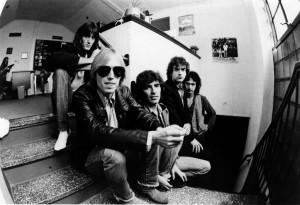
Damn Fine: Tom Petty (in shades) and the Heartbreakers in repose; Tench is second from right. Photo by Joel Bernstein.
Tench: Denny Cordell [the late producer and co-founder of Tom Petty’s first label, Shelter Records] told me a long time ago the reason some records sound so loud is because there’s less on them. And that makes me think of one of my favorite Heartbreakers songs, “Breakdown.” It has three guitars on it, but the essence of the record is Mike [Campbell]’s guitar lick, Tom [Petty]’s vocals, a solitary Wurlitzer, bass, and drums. It’s a very spare drum pattern. But when it comes on the radio, it catches your ear. It’s really got a lot of space. I think that’s the mark of a really good-sounding record.
We just captured a mood on that take. We had cut it earlier, and thought we had it. We had cut it with a grand piano, and it was a little bit different. But Tom called us back to the studio and said, “No.” So I think we maybe came back at 2 in the morning to recut it.
And it just takes that one moment. The good musicians can pretty much call up the moment. If the good bands, the good ensembles — whether they’re a gang of session musicians for [Van Morrison's] Moondance album, or a band like us — can catch what that wave is, you just grab onto it, and that’s The Grail. It’s “Twist and Shout,” “Things We Said Today,” “No Reply” — those songs are The Grail.
Mettler: The Heartbreakers always seem to find a few Grails whenever I see you live.
Tench: Thanks. Live playing is a more direct thing for me, where I don’t have to be cautious. You want to play a song like “Free Fallin’ ” as a pop song. Then you can do a song like “Runnin’ Down a Dream” as a hybrid. Because there isn’t any piano on that record, I can totally barrelhouse it up. When we play “(I’m Not Your) Steppin’ Stone” or “When the Time Comes” from the second record [You’re Gonna Get It!], it’s just basic, stripped down, simple rock and roll. And that’s what I really love about what we do in The Heartbreakers.
]]>
